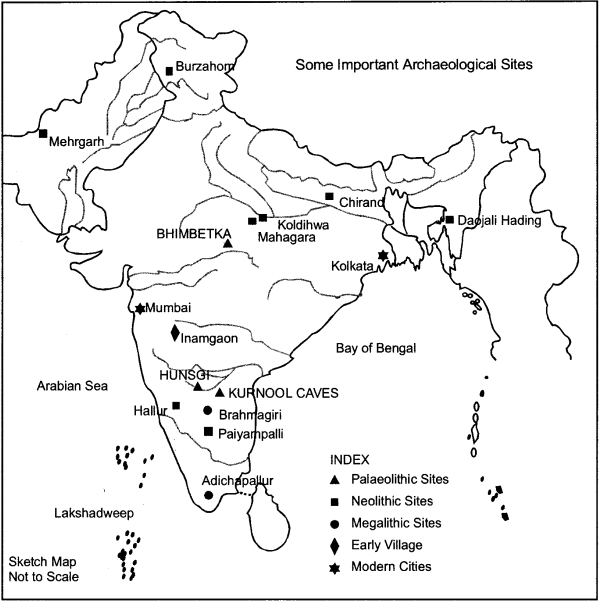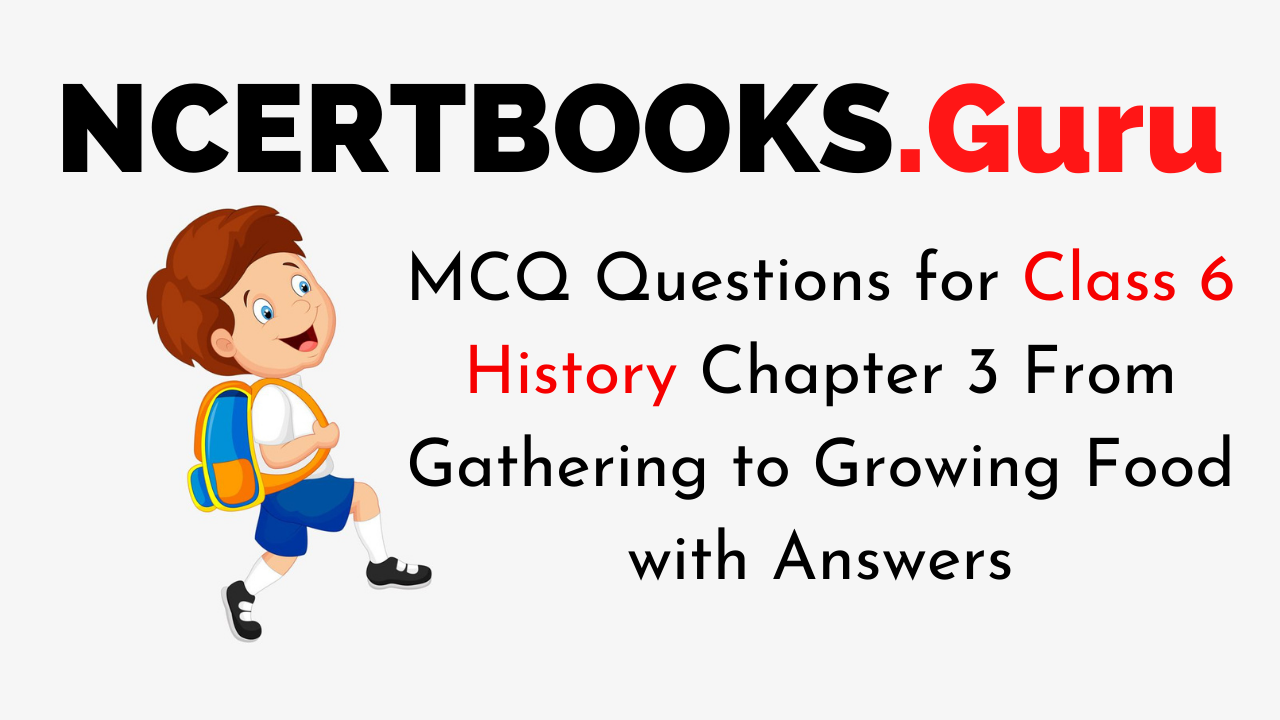MCQ Questions for Class 6 Social Science History Chapter 3 From Gathering to Growing Food Free PDF Download is available here. MCQ Questions for Class 6 Social Science History From Gathering to Growing Food are prepared as per the Latest Exam Pattern. Students can solve these Objective Questions of Class 6th Social Science History Ch 3 and assess their preparation level.
MCQ Questions for Class 6 Social Science History Chapter 3 From Gathering to Growing Food
Solving the Multiple Choice Questions of Class 6 Social Science History From Gathering to Growing Food can be of extreme help as you will be aware of all the concepts. These MCQ Questions on From Gathering to Growing Food pave for a quick revision of the Chapter thereby helping you to enhance subject knowledge. Have a glance at the Class 6 Social Science History From Gathering to Growing Food Multiple Choice Questions with Answers and cross check your answers during preparation.
Choose the correct answer:
1. Consider the following statements regarding Paleolithic period:
i. The word Paleolithic comes from two Greek words, ‘palaeo’, meaning old, and ‘lithos’, meaning stone.
ii. The Paleolithic period extends from 12,000 years ago till about 10,000 years.
Choose the correct option from the codes given below:
(a) Only i
(b) Only ii
(c) Both i and ii
(d) None of the above
Answer/Explanation
Answer: (a)
Explanation:
Archaeologists call the earliest period the Palaeolithic. This comes from two Greek words, ‘palaeo’, meaning old, and ‘lithos’, meaning stone. The name points to the importance of finds of stone tools. The Palaeolithic period extends from 2 million years ago to about 12,000 years ago. This long stretch of time is divided into the Lower, Middle and Upper Palaeolithic. This long span of time covers 99% of human history.
2. Consider the following statements regarding Mesolithic or Middle stone age:
i. Stone tools during this period was called “microliths”.
ii. Stone tools were large in size.
iii. Older variety of tools were absent during this period.
Choose the correct option from the codes given below:
(a) Only i and ii
(b) Only ii and iii
(c) Only i
(d) All the above
Answer/Explanation
Answer: (c)
Explanation:
• The period when we find environmental changes, beginning about 12,000 years ago till about 10,000 years ago is called the Mesolithic (middle stone) age.
• Stone tools found during this period are generally tiny, and are called microliths.
• Microliths were probably stuck on to handles of bone or wood to make tools such as saws and sickles.
• At the same time, older varieties of tools continued to be in use.
3. Around 12,000 years ago, there were major changes in the climate of the world. Consider the following statements:
i. It led to the development of Grassland.
ii. People started thinking about herding and rearing of animals
Choose the correct option from the codes given below:
(a) Only i
(b) Only ii
fc) Both i and ii
(d) None of the above
Answer/Explanation
Answer: (c)
Explanation:
- Around 12,000 years ago, there were major changes in the climate of the world, with a shift to relatively warm conditions. In many areas, this led to the development of grasslands. This in turn led to an increase in the number of deer, antelope, goat, sheep and cattle, i.e. animals that survived on grass.
- Those who hunted these animals now followed them, learning about their food habits and their breeding seasons. It is likely that this helped people to start thinking about herding and rearing these animals themselves. Fishing also became important.
4. Consider the following statements regarding Burzahom:
i. People built pit-houses.
ii. Cooking hearths were found both inside and outside the huts
Choose the correct option from the codes given below:
(a) Only i
(b) Only ii
(c) Both i and ii
(d) None of the above
Answer/Explanation
Answer: (c)
Explanation:
Archaeologists have found traces of huts or houses at some sites. For instance, in Burzahom (in present-day Kashmir) people built pit-houses, which were dug into the ground, with steps leading into them. These may have provided shelter in cold weather. Archaeologists have also found cooking hearths both inside and outside the huts, which suggests that, depending on the weather, people could cook food either indoors or outdoors.
5. Consider the following statements regarding Neolithic tools:
i. The tools were polished.
ii. Mortars and pestles were used for grinding grain.
Choose the correct option from the codes given below:
(a) Only i
(b) Only ii
(c) Both i and ii
(d) None of the above
Answer/Explanation
Answer: (c)
Explanation:
- Stone tools have been found from many sites as well. Many of these are different from the earlier Palaeolithic tools and that is why they are called Neolithic.
- These include tools that were polished to give a line cutting edge, and mortars and pestles were used for grinding grain and other plant produce.
- Mortars and pestles are used for grinding grain even today, several thousand years later.
- At the same time, tools of the Palaeolithic types continued to be made and used, and remember, some tools were also made of bone.
6. Consider the following statements regarding Mehrgarh:
i. Located in a fertile plain, near the Bolan Pass.
ii. People learnt to grow barley and wheat for the first time
iii. Square or rectangular houses were found
iv. Several burial sites have been found at Mehrgarh.
Choose the correct option from the codes give below:
(a) Only i and ii
(b) Only ii and iii
(c) Both i, iii and iv
(d) All the above
Answer/Explanation
Answer: (d)
Explanation:
- Mehrgarh site is located in a fertile plain, near the Bolan Pass, which is one of the most important routes into Iran. Mehrgarh was probably one of the places where people learnt to grow barley and wheat, and rear sheep and goats for the first time in this area.
- It is one of the earliest villages that we know about. At this site many animal bones were found.
- Bones of wild animals such as the deer and pig, and also bones of sheep and goat were found.
- Other finds at Mehrgarh include remains of square or rectangular houses. Each house had four or more compartments, some of which may have been used for storage.
- When people died, their relatives and friends generally paid respect to them. People looked after them, perhaps in the belief that there is some form of life after death.
- Burial is one such arrangement. Several burial sites have been found at Mehrgarh. In one instance, the dead person was buried with goats, which were probably meant to serve as food in the next world.
7. Arrange the Neolithic Sites from North to South:
i. Burzahom
ii. Mehrgarh
iii. Chirand
iv. Koldihwa
Choose the correct option from the codes given below :
(a) i, ii, iii, iv
(b) i, iii, ii, iv
(c) i, iv, iii, ii
(d) i, iii, iv, ii
Answer/Explanation
Answer: (a)
Explanation:

8. What type of food do we get from plants?
(a) Milk
(b) Meat
(c) Fruits, vegetable and grains
(d) None of these
Answer
Answer: (c) Fruits, vegetable and grains
9. Name the animal who gives us milk.
(a) Cow
(c) Sheep
(b) Goat
(d) All of these
Answer
Answer: (d) All of these
10. Select the animal for domestication.
(a) Lion
(b) Bear
(c) Dog
(d) Elephant
Answer
Answer: (c) Dog
11. Why did people store grains?
(a) For food
(b) As seeds
(c) Both (a) and (b)
(d) None of these
Answer
Answer: (c) Both (a) and (b)
12. Where is the evidence of wheat, barley, sheep, goat, cattle found?
(a) Koldihwa (UP)
(b) Gufkral (Kashmir)
(c) Mehrgarh (Pakistan)
(d) Hallur (Andhra Pradesh)
Answer
Answer: (c) Mehrgarh (Pakistan)
13. Who have found the evidence of ancient farmers and herders?
(a) Archaeologists
(b) Astrologists
(c) Biologists
(d) Historians
Answer
Answer: (a) Archaeologists
14. Which of the following is an important source of milk and meat?
(a) Tiger
(b) Dog
(c) Goat
(d) Cat
Answer
Answer: (c) Goat
15. Who have studied the customs and practices of present day farmers and herders?
(a) Archaeologists
(b) Scholars
(c) Astrologists
(d) None of these
Answer
Answer: (b) Scholars
16. Where is Mehrgarh located today?
(a) Uttar Pradesh
(b) Andhra Pradesh
(c) Pakistan
(d) China
Answer
Answer: (c) Pakistan
17. In the ancient time dead person was
(a) to serve as food in next life
(b) to serve as food in present life
(c) both (a) and (b)
(d) none of these
Answer
Answer: (a) to serve as food in next life
18. When did the domestication begin?
(a) About 12,000 years ago
(b) About 8,000 years ago
(c) About 6,000 years ago
(d) About 4,000 years ago
Answer
Answer: (a) About 12,000 years ago
Hope the information shared regarding MCQ Questions of Class 6 Social Science History Chapter 3 From Gathering to Growing Food is true and genuine as far as our knowledge is concerned. If you feel any information is missing do reac us and we will look into it and add it accordingly.
